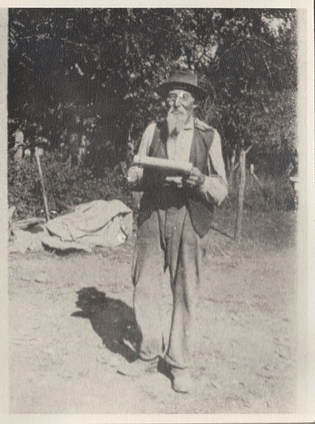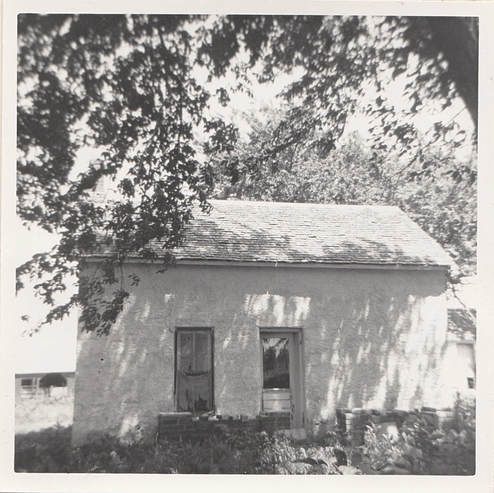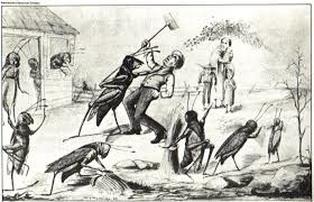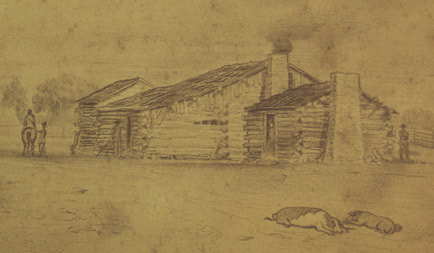A Day in the life...
First hand accounts from our local citizens
 Daniel H. Cupp, first settler of Towanda. Daniel H. Cupp, first settler of Towanda. There heve been several stories about the early days of Towanda and they all seem to vary a little as to the others, but one thing they all seem to agree about is Daniel Cupp being the first white settler to settle in this area along the Whitewater River. This is a story as told to the “Towanda News” by Daniel H. Cupp in the year 1916. This article was copied from the early newspaper by Hank Burchard. All of these newspapers will be available for review in the near future at the Museum. ____________________________________________________________________________________ “You should have been here in 1859 and 1860, as I was, if you think this is a dry hot time,” said pioneer D.H. Cupp to several who were discussing the discomforts and crop failures of the existing drought. Upon request of those present for the story of that time, Mr. Cupp said it was in December, 1859 that it stopped raining entirely. “The year I cam here, arriving on the Whitewater in the spring. There were several light rains in April and one or two during the summer, but none to do much good to what little crops that had been planted - - corn, potatoes, and garden truck. A little of which was harvested that fall, but not enough to feed the people. Bread stuffs were hauled in by wagon from Leavenworth. This, with meat, of which there was an abundance, such as buffalo, deer, antelope, wild turkey, prairie chickens, quail, which would be had for the killing, afforded everyone plenty to eat and aided the settlers to live through the following winter very comfortable. Our stock lived on the range had plenty of feed and came through in good condition. Cattle were fat enough for beef. Up to this time, with the exception of one light snow in January, no moisture had fallen. So ever, were went ahead an put in our crops, trusting providence for rain. But this time it disappointed us. A long, hot, dry fall, until the September when rain came, but too late to do any good. There was absolutely nothing raised and no surplus left from the preceding year, so we were up against it. Grass was but two to three inches high and could not be cut for hay. I and a neighbor, at one time during the summer noticed a little rain cloud down in the direction of Dry Creek and decided to try for hay there. We found a patch of grass about a foot high, which we mowed and raked by hand, getting seven loads for our work. No one lived near there; but wild cats and panthers were there, lots of them and they howled and screeched around our camp all night. We paid them no attention and they did not bother us further than that.  Cupp House Cupp House The few people that lived on the Whitewater and Walnut were in the stock business - raising cattle chiefly, and some horses and ponies. They did not put up much feed for the winter and stock lived on the range year round and the grass too short and cured on the ground was excellent feed and the stock lived through the winter in good shape with little care from the owner. At that time we thought this never would be anything but cattle country. We did not believe the uplands could grow anything except grass. The settlers along the streams discouraged immigrants all they could, telling them that they would starve to death; that there was no timber they could get, as it was all taken, and no railroads and no markets which they could reach with farm products other than cattle, and that there never would be. This policy had its effect. Settlers did not come until the latter part of the sixties. After this the country rapidly filled up and the range cattle business was coming to be a thing of the past.  The next dry spell of any note was in 1867. There would have been a little corn, but for the grasshoppers which came in September. The corn was just beginning to harden and hoppers going in to the fields ate it clean, leaving only the bare stalks. Again the people were without anything to eat but meat, and wild game was not so plentiful as it had been, but there were still plenty of cattle. Teams went to Leavenworth for supplies. The drought had extended over all the west and provisions were hard to get and prices were high. Corn meal was $10.00 per hundred, flour $15.00, sugar 25 cents per pound, and coffee 75 cents. Money was scarce and many families went without groceries and some of the time without bread. One feature of the time (a marked contrast with the present) was the hospitable and social condition existing among the people. Everybody was made welcome in their homes and all were equal. No one considered himself better than his neighbor. Their interests were in common. Those in trouble were aided; the sick were given care, selfishness and rivalry were unknown, as was the “back biting” and scandal. These came with the civilizations and progression of the present.  Meads trading post Meads trading post The beginning of Towanda at its present site was the building of a log house at the foot of the hill near the spring by C.L. Chandler, a forty-niner returning from California in 1858. This after-ward was sold with his claim to James R. Mead and used as an Indian trading post. A post office was established and mail carried by “buckboard” twice a month from Topeka. I was the first post master and this office received mail for all living west to the Colorado line. The first town platted on the Whitewater was by a party of men from Topeka in 1856, on the west side of the river near my home. They dug and walled a large cellar over which a log house designed for trading post, was built. Upon discovering pearls in the Whitewater, the town builders became pearl fishers. Wading in the stream gave them malaria. The pearls having proved worthless, they abandoned this country, never returning. The log building, following the failure was used as a “town house” several years for public meetings, and for the first school taught here. It was finally torn down. The settlers lived in log houses, usually of one room and often with no floor other than the ground. They were as a rule, situated near the creeks with small fenced fields adjoining.
Occasionally there were religious meetings held at the settlers homes, but more often it was a dance and other social gatherings. People from the Walnut always attended these Whitewater events. The question of dress did not concern the ladies. Calico was a popular dress material. And often the men were more elaborately clothed then the women. Bandana handkerchiefs adorned their hats and arms, and the revolver and belt was always in evidence. Horse racing was a popular amusement. However, little money changed hands at the races. In fact, there was little money in the country, and the people were not addicted to gambling. For years, there was only one doctor in the country. He lived on the Walnut and attended the sick all over Butler County."
0 Comments
Leave a Reply. |
Archives
January 2024
Categories |